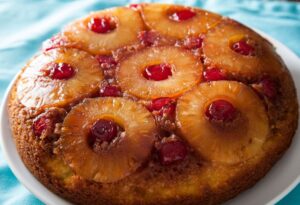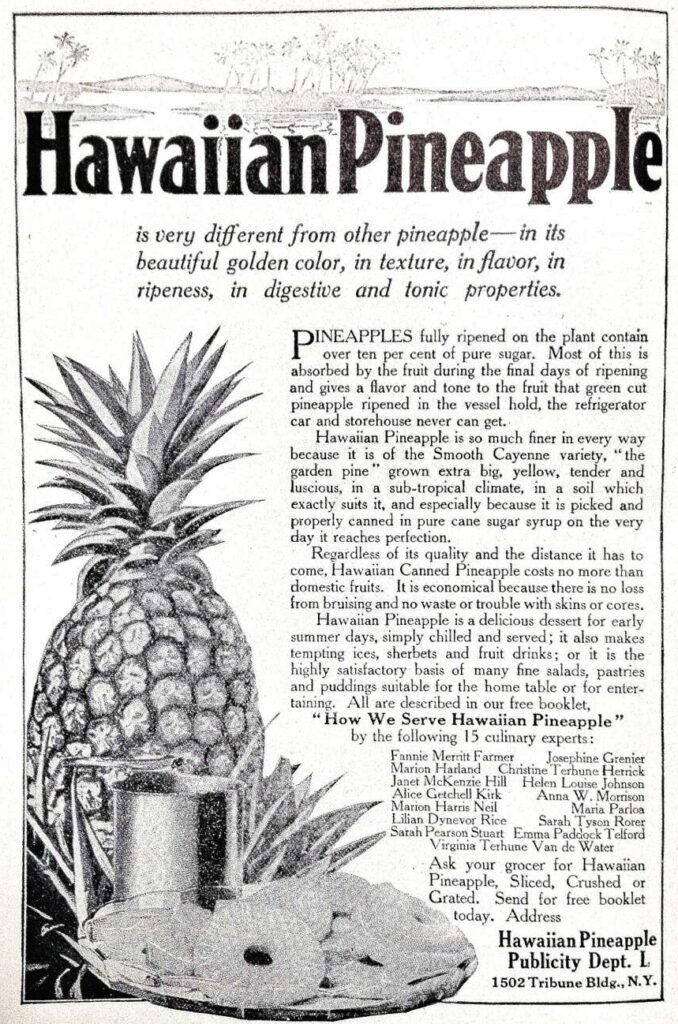Sydney Fuhrman
Watch our Education Coordinator attempt to make this 1920s cake:
 Pineapple desserts exploded in popularity in the 1920s both in the United States and Canada. Suddenly you see them in cookbooks, at picnics and in baking competitions. But why? Pineapples are a tropical fruit so why are we seeing them expand in popularity during the roaring 20s?
Pineapple desserts exploded in popularity in the 1920s both in the United States and Canada. Suddenly you see them in cookbooks, at picnics and in baking competitions. But why? Pineapples are a tropical fruit so why are we seeing them expand in popularity during the roaring 20s?
It all comes back to canning. In 1795 French Emperor Napoleon Bonaparte offered a reward to anyone who could come up with a way to safely preserve food for his army’s consumption. Nicholas Appert rose to the challenge and invented a method that involved heat-processing food in glass jars and then sealing them with wax. Around the same time an Englishman named Peter Durand developed a method of putting food into tin cans. By the beginning of the 20th Century commercial canned goods were being made around the world, however it wasn’t something that was regularly consumed by your average household. In fact it was primarily used for luxury products like oysters and was often quite expensive. Most homemakers wouldn’t have bought canned goods. They made simple dishes from scratch to feed their families.
World War I marked a turning point. On the frontlines the trenches were too small and cramped to allow for canteens and kitchens so to keep the huge armies fed something had to change. War efforts needed massive amounts of easy, filling, cheap food that could be quickly transported to the front lines. In response, canning companies expanded. They started making tinned beef, canned vegetables and more to feed the soldiers. Now full meals came in cans, not just luxury products. Then, when the war ended in 1918 the companies still had the facilities to continue making good quality, inexpensive canned food and what is more, the soldiers who returned home had spent years developing a taste for the stuff. Thus, thanks to World War I and trench warfare, canned food became a household staple.
For an example look no further than our local Saanich Canning Company. Opened by Jim White in 1903, they started by canning clams in their own nectar but by the 1920s they were canning local fruit and vegetables.
Around this same time, the Hawaiian pineapple industry was taking off.
Pineapples actually have an amazing history. Long before any Europeans laid eyes on it, pineapple was planted, farmed and regularly consumed by the Indigenous peoples of modern day South America and the Caribbean. When Europeans first tasted the fruit they fell in love with it and tried to grow it themselves, but that’s very hard to do in Europe. This led to the pineapple being a symbol of wealth, with people even renting pineapples to carry around at parties.
But back on topic: In 1906 James Dole, the creator of the Hawaiian Pineapple Company, built a cannery in Honolulu that allowed the company to package pineapple at its ripest. Earlier efforts had picked the pineapple when it was green and allowed it to ripen during transport before canning it, which produced something that looked like pineapple, but didn’t taste nearly as good. By 1923 Dole had outstripped every other producer of canned pineapple and demand for the yellow fruit was surging in the United States. 
Of course we also got our fix of the yellow fruit up north. The 1920s is the decade that marked Canada officially trading more with the United States than with the United Kingdom. So while we still would have paid tariffs on imported goods like canned pineapples, Canadians were buying it. In fact in 1926 Ottawa cut duties on goods like coffee, spices, and pineapples. The cans were coming, and Canadians could make the brightly coloured desserts for themselves.
This perfect kismet of events led to the recipes like pineapple upside-down cakes and other desserts blowing up in the 1920s. Pineapple was delicious and thanks to the spread of mass-produced canned goods, people could get their hands on it.
Be sure to share on social media whatever you create and tag the Sidney Museum.
Facebook: @SidneyMuseum, Twitter: @SidneyMuseum, Instagram: @sidneymuseum
Pineapple Upside-Down Cake
Adapted from “A Guide to Good Cooking” by “The Housewives of Canada” (1938)
Ingredients
- 3 tbsp butter
- 1/2 cup brown sugar (more if desired)
- Pineapple rings, from one can or one fresh pineapple
- Pecans, walnuts or raisins (optional)
- 6 eggs, separated
- 1 cup sugar, sifted and divided
- 1 tbsp lemon juice
- 1 tbsp cold water
- 1 cup of flour, sifted
- pinch of salt
- zest from half a lemon
- Maraschino cherries
Method
- Preheat the oven to 325 degrees.
- Melt the butter in a large cast iron skillet over low heat, spreading it around and up the sides to ensure the entire pan is greased
- Add the brown sugar, spreading it equally on the bottom and sides of the pan. Add more sugar if necessary – it should form a generous layer of sugar. Continue to cook it on low heat until the sugar starts to melt, but is not completely liquid.
- Remove from heat and cover the bottom of the pan in the pineapple rings, filling the spaces between with pecans, walnuts or raisins if you want. Set aside.
- In a large bowl beat the egg whites until they are stiff but not dry. Beat in a 1/2 cup of the sugar gradually, thoroughly combining between additions.
- In another bowl beat the egg yolks until they are thick and have turned a light yellow. Add the other 1/2 cup of sugar gradually, thoroughly combining between additions. Beat in the lemon juice and water.
- Combine the whites and the yolks by gently cutting and folding. Be careful not to overmix.
- Cut and fold in the flour, salt and zest until just combined, again being careful not to overmix.
- Pour the cake batter into the skillet and gently spread it evenly.
- Bake in oven for 45 min – 1 hr. Until the top is a light golden brown and the cake bounces back when pressed.
- Let it cool in the pan for 20 minutes to help it set, then (carefully as the pan will still be hot) flip the pan over a serving plate.
- If parts of the fruit topping stick to the pan, replace them in the cake as best you can.
- While the cake is still warm, insert the maraschino cherries into the holes in the pineapple rings, and wherever else you see fit.
- Allow to cool before serving.